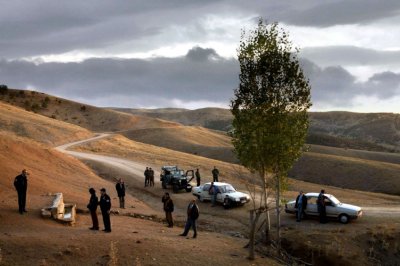Reviews - Once Upon A Time in Anatolia
Once Upon A Time in Anatolia
Reviewed By John Stakes

Once Upon A Time in Anatolia
A CSI investigation. Or rather a Ceylan Steppes Investigation took place last Sunday when celebrated Turkish director Nuri Bilge Ceylan (a man nominated for no less than twenty three awards in a distinguished career), took us and a motley group of men into the arid regions of Anatolia to find a body.
But unlike the setting for most western crime scene investigations this was to prove a completely different experience in the hands of a director whose cinematic signature is arguably unique. “Once Upon A Time in Anatolia” contains all the directional DNA we have come to expect from him in films such a “Three Monkeys” and “Climates”: long, static takes with little editing. Basically, nothing appears to happen….for a very long time it seems, though the events covered here span less than twenty four hours. In mainstream film-making the cadaver and its condition when found, would be the focus of attention from which the search to identify the killer would spring and to which everything else would be subordinate. In Ceylan’s world the search is more important than the discovery. And that is not the only difference.
In Ceylan’s film the murderers are disclosed almost from the outset. But the body has not yet been found. It is out there somewhere because two of the group of twelve (initially unidentified) men, alighting from three vehicles in the middle of nowhere, have been arrested and are leading the police to the corpse possibly as part of a sentence bargain. The trouble is that the landscape is bereft of distinguishing features which might assist in locating it (one watering hole looks very much like the next), and the search extends well into the night after we join it just after dusk.
But why are we told nothing about these deliberately shadowy men before the story gets under way? The answer lies in the fact that Ceylan, in the knowledge that all concerned know there is a body, is primarily concerned with the effect of the search on the personalities and dynamics of the group; the body, whilst not irrelevant, is secondary. The choice of landscape and the timing of the search is merely a device enabling Ceylan to bide and buy his time. His camera is trained only in an observational capacity as if Ceylan himself knew not what impact this situation would have on this disparate party but decided to film whatever emerged.
Consequently we seem to be watching an unedited docudrama unfolding at a rate which allows events to unfurl at their own pace. This may not be to everyone’s liking but for those on his radar, Ceylan makes us look for significance in the smallest of actions or exchanges of which there are precious few, but, each of which, in its own way, is nonetheless deeply weighty.
The group comprises police officers, a doctor, a prosecutor, some grave diggers, and two brothers, the suspects. They are all in tow as Kenan, one of the suspects, with a reticence bordering on resistance, is taken from one water hole to another to jog his memory. Unfortunately he tells his captors that he was drunk when the crime was committed and cannot remember exactly where the foul deed was done. But, burdened by a dreadful secret, does he truly wish the body to be found?
The men gradually exchange seemingly inconsequential banter. There is a great scene in the car for example where the police are in jocular mode as the camera slowly moves through the car to focus on Kenan’s impassive face. Later Prosecutor Nusret and Cemal the doctor discuss one of Nusret’s more mysterious cases which they return to the following morning. A woman had died of an apparent heart attack after childbirth. There was no autopsy. But she may have committed suicide because of her husband’s infidelity. The strong implication from the gradual change in prosecutor’s demeanour in telling the story is that Nusret may have been none other than the husband.
After a shared meal the previous night served by the mayor’s serenely beautiful Madonna-like daughter, Kenan confesses that the victim’s son was his and that things then became ugly. The following morning the body is recovered and taken to a local hospital for autopsy. The mother and son are waiting, their grief and anger obvious. The doctor carries out the autopsy which indicates the victim may have been buried alive. Nusret leaves the room aware of the significance of this finding to his own life. The doctor then omits this finding from his report.
The film has by now morphed into becoming a meditation on the impact of death on all who are close to or touched by it. The police remain indifferent to it at least until its condition is revealed, and the mortuary officials are not only clinically detached from it but more concerned with trivia as they go about their work. The killer confesses following his vision of the Madonna and his victim. The perspiring prosecutor all but confesses responsibility for his wife’s death. The (divorced and childless) doctor who, professionally, is as regularly close to death as anyone can be, and acutely conscious of the aridity of his personal life, compromises his professional integrity to mitigate the grief of the victim’s widow.
The cinematography by Gokhan Tiryaki was stunningly evocative throughout, the imagery creating a lingering sense of mystery (the memorable streaking line of three vehicle headlights for example) to complement the film’s abiding melancholy. Notwithstanding the vein of occasionally mildly light but mainly black comedy running through the film (in Cohen Brother-style with the body in the boot scene for example), the prevailing sense of depression is never lifted. Ceylan co-wrote the screenplay which was apparently based on a true event concerning his co-writer.
Patience by the police and audience was required to reap any rewards from this exercise in existentialism, but the returns on this investment were great. The film was joint winner of the Grand Prix at the 2011 Cannes Film Festival alongside “The Kid With The Bike” which is to be shown later in what is turning out to be a most compelling season. As Vaughan Ames wrote in the Reminder last week “who said cinema is dead?” There may be screen bodies aplenty at present but The Alhambra patient is very much alive and rejuvenated.
Next Sunday features a double bill no less….and food! Right now the Alhambra is the place to be.
But unlike the setting for most western crime scene investigations this was to prove a completely different experience in the hands of a director whose cinematic signature is arguably unique. “Once Upon A Time in Anatolia” contains all the directional DNA we have come to expect from him in films such a “Three Monkeys” and “Climates”: long, static takes with little editing. Basically, nothing appears to happen….for a very long time it seems, though the events covered here span less than twenty four hours. In mainstream film-making the cadaver and its condition when found, would be the focus of attention from which the search to identify the killer would spring and to which everything else would be subordinate. In Ceylan’s world the search is more important than the discovery. And that is not the only difference.
In Ceylan’s film the murderers are disclosed almost from the outset. But the body has not yet been found. It is out there somewhere because two of the group of twelve (initially unidentified) men, alighting from three vehicles in the middle of nowhere, have been arrested and are leading the police to the corpse possibly as part of a sentence bargain. The trouble is that the landscape is bereft of distinguishing features which might assist in locating it (one watering hole looks very much like the next), and the search extends well into the night after we join it just after dusk.
But why are we told nothing about these deliberately shadowy men before the story gets under way? The answer lies in the fact that Ceylan, in the knowledge that all concerned know there is a body, is primarily concerned with the effect of the search on the personalities and dynamics of the group; the body, whilst not irrelevant, is secondary. The choice of landscape and the timing of the search is merely a device enabling Ceylan to bide and buy his time. His camera is trained only in an observational capacity as if Ceylan himself knew not what impact this situation would have on this disparate party but decided to film whatever emerged.
Consequently we seem to be watching an unedited docudrama unfolding at a rate which allows events to unfurl at their own pace. This may not be to everyone’s liking but for those on his radar, Ceylan makes us look for significance in the smallest of actions or exchanges of which there are precious few, but, each of which, in its own way, is nonetheless deeply weighty.
The group comprises police officers, a doctor, a prosecutor, some grave diggers, and two brothers, the suspects. They are all in tow as Kenan, one of the suspects, with a reticence bordering on resistance, is taken from one water hole to another to jog his memory. Unfortunately he tells his captors that he was drunk when the crime was committed and cannot remember exactly where the foul deed was done. But, burdened by a dreadful secret, does he truly wish the body to be found?
The men gradually exchange seemingly inconsequential banter. There is a great scene in the car for example where the police are in jocular mode as the camera slowly moves through the car to focus on Kenan’s impassive face. Later Prosecutor Nusret and Cemal the doctor discuss one of Nusret’s more mysterious cases which they return to the following morning. A woman had died of an apparent heart attack after childbirth. There was no autopsy. But she may have committed suicide because of her husband’s infidelity. The strong implication from the gradual change in prosecutor’s demeanour in telling the story is that Nusret may have been none other than the husband.
After a shared meal the previous night served by the mayor’s serenely beautiful Madonna-like daughter, Kenan confesses that the victim’s son was his and that things then became ugly. The following morning the body is recovered and taken to a local hospital for autopsy. The mother and son are waiting, their grief and anger obvious. The doctor carries out the autopsy which indicates the victim may have been buried alive. Nusret leaves the room aware of the significance of this finding to his own life. The doctor then omits this finding from his report.
The film has by now morphed into becoming a meditation on the impact of death on all who are close to or touched by it. The police remain indifferent to it at least until its condition is revealed, and the mortuary officials are not only clinically detached from it but more concerned with trivia as they go about their work. The killer confesses following his vision of the Madonna and his victim. The perspiring prosecutor all but confesses responsibility for his wife’s death. The (divorced and childless) doctor who, professionally, is as regularly close to death as anyone can be, and acutely conscious of the aridity of his personal life, compromises his professional integrity to mitigate the grief of the victim’s widow.
The cinematography by Gokhan Tiryaki was stunningly evocative throughout, the imagery creating a lingering sense of mystery (the memorable streaking line of three vehicle headlights for example) to complement the film’s abiding melancholy. Notwithstanding the vein of occasionally mildly light but mainly black comedy running through the film (in Cohen Brother-style with the body in the boot scene for example), the prevailing sense of depression is never lifted. Ceylan co-wrote the screenplay which was apparently based on a true event concerning his co-writer.
Patience by the police and audience was required to reap any rewards from this exercise in existentialism, but the returns on this investment were great. The film was joint winner of the Grand Prix at the 2011 Cannes Film Festival alongside “The Kid With The Bike” which is to be shown later in what is turning out to be a most compelling season. As Vaughan Ames wrote in the Reminder last week “who said cinema is dead?” There may be screen bodies aplenty at present but The Alhambra patient is very much alive and rejuvenated.
Next Sunday features a double bill no less….and food! Right now the Alhambra is the place to be.
Find A Film
Search over 1475 films in the Keswick Film Club archive.
Friends
KFC is friends with Caldbeck Area Film Society and Brampton Film Club and members share benefits across all organisations
Awards
Keswick Film Club won the Best New Film Society at the British Federation Of Film Societies awards in 2000.
Since then, the club has won Film Society Of The Year and awards for Best Programme four times and Best Website twice.
We have also received numerous Distinctions and Commendations in categories including marketing, programming and website.
 Talking Pictures
The KFC Newsletter
Talking Pictures
The KFC Newsletter
Links Explore the internet with Keswick Film Club


